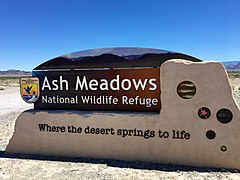| Ash Meadows National Wildlife Refuge | |
|---|---|
IUCN category IV (habitat/species management area) | |
 Ash Meadows habitat, in the
Amargosa Desert. | |
Map of the
United States | |
| Location | Nye County, Nevada, United States |
| Nearest city | Pahrump, Nevada |
| Coordinates | 36°25′30″N 116°20′00″W / 36.42500°N 116.33333°W |
| Area | 23,000 acres (93 km2) |
| Established | 1984 |
| Governing body | U.S. Fish and Wildlife Service |
| Website | Ash Meadows National Wildlife Refuge |
| Designated | 18 December 1986 |
| Reference no. | 347 [1] |
The Ash Meadows National Wildlife Refuge is a protected wildlife refuge located in the Amargosa Valley of southern Nye County, in southwestern Nevada. It is directly east of Death Valley National Park, and is 90 mi (140 km) west-northwest of Las Vegas. [2]
In 1983 The Nature Conservancy purchased 12,613 acres that had been slated for development to protect Ash Meadows. The Nature Conservancy transferred the land to the Fish and Wildlife Serve and the refuge was created on June 18, 1984, to protect this extremely rare desert oasis in the Mojave Desert. [3]
Ash Meadows is administered by the U.S. Fish and Wildlife Service. [2]
Geography
The 23,000-acre (9,300 ha) Ash Meadows National Wildlife Refuge is part of the larger Desert National Wildlife Refuge Complex, which also includes the Desert National Wildlife Refuge, the Moapa Valley National Wildlife Refuge, and the Pahranagat National Wildlife Refuge. Inside Ash Meadows is Devils Hole, a detached unit of Death Valley National Park.
Ash Meadows is within the Amargosa Desert, of the Mojave Desert ecoregion. The Amargosa River is a visible part of the valley hydrology, and has seasonal surface flow passing southwards adjacent to the preserve, to later enter Death Valley.
Natural history
Ash Meadows provides a valuable and unprecedented example of desert oases habitats, that have become extremely uncommon in the southwestern deserts. The refuge is a major discharge point for a vast underground aquifer water system, reaching more than 100 mi (160 km) to the northeast. Water-bearing strata come to the surface in more than thirty seeps and springs, providing a rich, complex variety of mesic habitats. [2]
Virtually all of the water at Ash Meadows is fossil water, believed to have entered the ground water system tens of thousands of years ago. [4]
Numerous stream channels and wetlands are scattered throughout the refuge. To the north and west are the remnants of Carson Slough, which was drained and mined for its peat in the 1960s. Sand dunes occur in the western and southern parts of the refuge.
Endemic plants and animals
Ash Meadows National Wildlife Refuge was established to provide and protect habitat for at least twenty-six endemic plants and animals, meaning they are found nowhere else in the world. [5] [6] Four fish and one plant are currently listed as endangered species.
The concentration of locally exclusive flora and fauna that distinguishes Ash Meadows is the greatest concentration of endemic biota in any local area within the United States. It has the second greatest local endemism concentration in all of North America.
-
The endangered Amargosa pupfish in Kings Pool
-
Crystal Spring in Ash Meadow
-
Ash Meadows NWR entry sign 2017-05-14
Endemic flora
There are many plants endemic to Ash Meadows, including: [2]
- Ash Meadows sunray (Enceliopsis nudicaulis var. corrugata)
- Ash Meadows blazingstar (Mentzelia leucophylla)
- Ash Meadows gumplant (Grindelia fraxino-pratensis)
- Ash Meadows milkvetch (Astragalus phoenix)
- Amargosa niterwort (Nitrophila mohavensis)
- Spring-loving centaury (Zeltnera namophila)
Discoveries
In 2010, Utah State University announced that a team from the school had discovered two new bee species in the genus Perdita at Ash Meadows. [6]
References
- ^ "Ash Meadows National Wildlife Refuge". Ramsar Sites Information Service. Retrieved 25 April 2018.
- ^ a b c d Ash Meadows National Wildlife Refuge Archived June 19, 2006, at the Wayback Machine
- ^ "Places We Protect, Ash Meadows". The Nature Conservancy. Retrieved April 12, 2024.
- ^ FWS.gov: Profile . accessed 10.1.2013
- ^ "Welcome To Ash Meadows NWR". U.S. Fish and Wildlife Service. 2010-02-17. Archived from the original on 10 April 2010. Retrieved 2010-04-19.
- ^ a b "Two bee species discovered near Las Vegas". Las Vegas Review-Journal. Associated Press. 2010-04-19.
External links
- IUCN Category IV
- Desert National Wildlife Refuge Complex
- Amargosa Desert
- National Wildlife Refuges in Nevada
- Protected areas of Nye County, Nevada
- Ramsar sites in the United States
- Wetlands of Nevada
- Protected areas established in 1984
- 1984 establishments in Nevada
- Landforms of Nye County, Nevada
- Meadows in the United States




